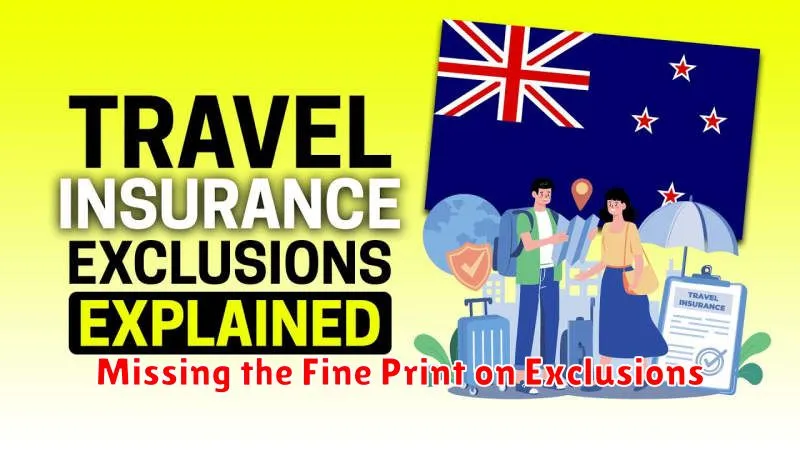Planning a trip? Travel insurance is a crucial aspect of responsible travel planning, protecting you from unforeseen circumstances that can disrupt your adventures and incur significant costs. From medical emergencies to lost luggage, trip cancellations, and unexpected delays, the right travel insurance policy can provide financial security and peace of mind. However, many travelers make costly mistakes when selecting and utilizing their travel insurance, leaving them vulnerable and exposed to unnecessary risks. Understanding the common pitfalls associated with travel insurance is essential to maximizing its benefits and ensuring a worry-free travel experience.
This article will explore the top mistakes travelers often make regarding travel insurance, providing valuable insights to help you navigate the complexities of choosing the right coverage. By avoiding these common errors, you can ensure your travel insurance policy effectively safeguards your trip investment and provides adequate protection against potential disruptions. Learn how to choose the right policy, understand the fine print, and avoid the common misconceptions that can leave you stranded without the coverage you need. Protecting your travel investment begins with understanding travel insurance and avoiding these critical mistakes.
Not Reading the Policy Terms Carefully
One of the most common and costly mistakes travelers make is not thoroughly reading their travel insurance policy documents. Many people purchase a policy and assume they’re covered for everything, only to discover during a claim that specific situations or events are excluded.
Carefully review the policy wording to understand what is and isn’t covered. Pay close attention to the definitions of key terms, such as “pre-existing medical condition,” “trip interruption,” and “baggage delay.” Understand the claim filing procedures and any time limits involved. Ignoring the fine print can lead to denied claims and significant financial losses.
Coverage limitations and exclusions vary greatly between policies. One policy might cover lost luggage due to airline error, while another might not. Some policies offer coverage for adventure sports, while others specifically exclude them. Be aware of these nuances to avoid unpleasant surprises.
Choosing the Cheapest Policy Only
One of the most common mistakes travelers make is focusing solely on the price tag when selecting travel insurance. While budget considerations are important, opting for the absolute cheapest policy can leave you significantly underinsured. Coverage is the critical factor, not just cost. A cheaper policy may lack crucial benefits like sufficient medical expense coverage, emergency medical evacuation, or trip interruption coverage for unforeseen events.
Inexpensive policies often come with high deductibles and low coverage limits. This means that while your upfront cost is minimal, you’ll end up paying a significant portion of any claim out of pocket. Imagine needing medical attention abroad and discovering your policy only covers a fraction of the expenses. Consider a policy with a lower deductible and higher coverage limits, even if the premium is slightly higher, to ensure adequate protection in case of a serious incident.
Furthermore, the cheapest policies may exclude common travel disruptions. Lost baggage, flight cancellations, or unforeseen natural disasters might not be covered, leaving you to shoulder the financial burden. Carefully evaluate the policy details to understand what is and isn’t covered, rather than simply choosing based on the premium alone. A slightly more expensive policy offering comprehensive coverage is often a more prudent investment in your travel security.
Missing the Fine Print on Exclusions

One of the most common and costly mistakes travelers make with travel insurance is overlooking the exclusions listed in their policy. While a policy may appear comprehensive at first glance, the fine print often details specific situations and circumstances where coverage is not provided.
Failing to carefully review these exclusions can lead to unexpected out-of-pocket expenses. Common exclusions include pre-existing medical conditions, engaging in extreme sports or adventure activities, travel to countries under government travel advisories, and cancellations due to foreseeable events.
For instance, if you have a pre-existing medical condition and experience a related medical emergency during your trip, your claim could be denied if your policy excludes such conditions. Similarly, if you plan on participating in activities like scuba diving or rock climbing, ensure your policy specifically covers these high-risk activities.
Carefully scrutinize the policy wording regarding covered reasons for trip cancellations. Often, cancellations due to personal reasons, fear of travel, or changing your mind are not covered. Thoroughly reading and understanding the exclusions is crucial to avoid unpleasant surprises and ensure you have the right coverage for your trip.
Not Declaring Pre-Existing Conditions

A critical mistake travelers often make is failing to declare pre-existing medical conditions when purchasing travel insurance. Pre-existing conditions are any illnesses, injuries, or medical conditions you were aware of before your policy’s effective date. This includes diagnosed conditions, ongoing treatments, and even symptoms you’ve experienced but haven’t yet received a diagnosis for.
Failing to disclose these conditions can have severe repercussions. Your insurance provider might deny your claim if you require medical attention related to a pre-existing condition that wasn’t declared. This could leave you responsible for significant medical expenses abroad. Some policies offer coverage for pre-existing conditions, but this usually requires specific declarations and possibly additional premiums. Honesty and transparency are crucial when applying for travel insurance.
Carefully review the policy’s definition of pre-existing conditions. If you’re unsure whether a particular condition needs to be declared, it’s best to err on the side of caution and disclose it. Contact your insurer directly to discuss any concerns and ensure you have the appropriate coverage for your specific needs.
Waiting Too Long to Purchase Coverage
One of the most common mistakes travelers make is waiting too long to purchase travel insurance. Many assume they can buy it right before their trip, but this can be a costly oversight. Purchasing travel insurance should be one of the first things you do after booking your trip, not the last.
Several benefits are tied to purchasing a policy early. For example, many policies offer a “cancel for any reason” (CFAR) upgrade, which typically must be purchased within a short window, often 10-20 days, of your initial trip deposit. This upgrade provides the most flexibility if you need to cancel, offering reimbursement for a significant percentage of your prepaid, non-refundable trip costs. Waiting too long means missing out on this valuable option.
Additionally, unforeseen events can occur before your departure that may require you to cancel or interrupt your trip. Illness, job loss, or a family emergency can happen unexpectedly. Purchasing insurance early ensures you’re protected from these potential disruptions. It also often provides coverage for pre-existing medical conditions if you purchase your policy within the specified timeframe after making your initial trip deposit.
Forgetting to Carry Proof of Insurance
One common mistake travelers make is forgetting to carry proof of travel insurance. While you might have purchased a policy, it’s crucial to have accessible documentation while traveling. Imagine needing to make a claim for a medical emergency or lost baggage – without readily available policy information, the process becomes significantly more challenging and stressful.
Always carry a physical or digital copy of your insurance policy. This includes your policy number, emergency contact information, and details of coverage. A digital copy on your phone or tablet is often the most convenient option, ensuring access even if your physical documents are lost or stolen. Consider storing it in a readily accessible location, such as a designated travel folder on your device or in a secure cloud-based storage service.
Also, be sure to familiarize yourself with the claims process outlined in your policy before your trip. Understanding the required documentation and procedures can save valuable time and minimize hassle should an incident occur. Know what information you need to gather, such as receipts or medical reports, to facilitate a smooth claims experience.
How to Claim Properly If Needed
While we hope you never need to use your travel insurance, understanding the claims process is crucial. Proper documentation is key to a successful claim. Keep all receipts, medical reports, police reports (if applicable), and any communication with service providers.
Contact your insurance provider as soon as possible after an incident occurs. Delays can complicate the claims process. Many providers have 24/7 emergency assistance lines specifically for these situations. Be prepared to provide your policy number and a detailed account of the event.
Follow the specific instructions given by your provider. They may have specific forms to complete or procedures to follow. Thoroughly review your policy to understand the coverage details and claim requirements. This will help ensure you have the necessary documentation and meet all deadlines.
Be honest and accurate in your claim submission. Providing false information can invalidate your policy and lead to claim denial.

